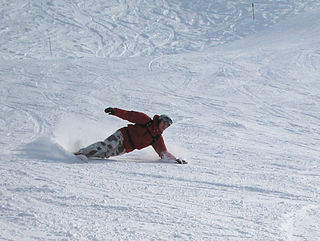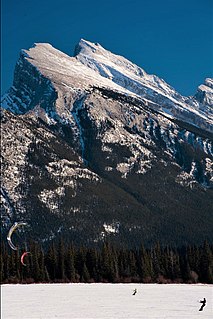
Snowboards are boards where both feet are secured to the same board, which are wider than skis, with the ability to glide on snow. Snowboards widths are between 6 and 12 inches or 15 to 30 centimeters. Snowboards are differentiated from monoskis by the stance of the user. In monoskiing, the user stands with feet inline with direction of travel, whereas in snowboarding, users stand with feet transverse to the longitude of the board. Users of such equipment may be referred to as snowboarders. Commercial snowboards generally require extra equipment such as bindings and special boots which help secure both feet of a snowboarder, who generally rides in an upright position. These types of boards are commonly used by people at ski hills or resorts for leisure, entertainment, and competitive purposes in the activity called snowboarding.

Skiing is a means of transport using skis to glide on snow. Variations of purpose include basic transport, a recreational activity, or a competitive winter sport. Many types of competitive skiing events are recognized by the International Olympic Committee (IOC), and the International Ski Federation (FIS).
A ski is a narrow strip of semi-rigid material worn underfoot to glide over snow. Substantially longer than wide and characteristically employed in pairs, skis are attached to ski boots with ski bindings, with either a free, lockable, or partially secured heel. For climbing slopes, ski skins can be attached at the base of the ski.

Wakeboarding is a water sport in which the rider, standing on a wakeboard, is towed behind a motorboat across its wake and especially up off the crest in order to perform aerial maneuvers. A hallmark of wakeboarding is the attempted performance of midair tricks. Wakeboarding was developed from a combination of water skiing, snowboarding and surfing techniques.

Winter sports or winter activities are competitive sports or non-competitive recreational activities which are played on snow or ice. Most are variations of skiing, ice skating and sledding. Traditionally, such games were only played in cold areas during winter, but artificial snow and artificial ice allow more flexibility. Artificial ice can be used to provide ice rinks for ice skating, ice hockey, and bandy in a milder climate.

Snowboarding is a recreational and competitive activity that involves descending a snow-covered slope while standing on a snowboard attached to a rider's feet. It features in the Winter Olympic Games and Winter Paralympic Games.

Alpine skiing, or downhill skiing, is the pastime of sliding down snow-covered slopes on skis with fixed-heel bindings, unlike other types of skiing, which use skis with free-heel bindings. Whether for recreation or for sport, it is typically practised at ski resorts, which provide such services as ski lifts, artificial snow making, snow grooming, restaurants, and ski patrol.
Freestyle skiing is a skiing discipline comprising aerials, moguls, cross, half-pipe, slopestyle and big air as part of the Winter Olympics. It can consist of a skier performing aerial flips and spins, and can include skiers sliding rails and boxes on their skis. It is also commonly referred to as freeskiing, jibbing, as well as many other names around the world.

Skiing, or traveling over snow on skis, has a history of at least eight millennia. The earliest archaeological examples of skis were found in Russia and date to 6000 BCE. Although modern skiing has evolved from beginnings in Scandinavia, 5000-year-old wall paintings suggest use of skis in the Xinjiang region of what is now China; however, this continues to be debated. Originally purely utilitarian, starting in the mid-1800s skiing became a popular recreational activity and sport, becoming practiced in snow-covered regions worldwide, and providing a market for the development of ski resorts and their related communities.
Ski boots are footwear used in skiing to provide a way to attach the skier to skis using ski bindings. The ski/boot/binding combination is used to effectively transmit control inputs from the skier's legs to the snow.

Backcountry skiing (US), also called off-piste (Europe), alpine touring, or out-of-area, is skiing in the backcountry on unmarked or unpatrolled areas either inside or outside a ski resort's boundaries. This contrasts with alpine skiing which is typically done on groomed trails benefiting from a ski patrol. Unlike ski touring, backcountry skiing can include the use of ski lifts including snowcats and helicopters. Recent improvements in equipment have increased the popularity of the sport.

A skwal is the main piece of equipment used for skwalling, a hybrid sport combining the carving of skiing and riding feel of snowboarding. It is similar to a snowboard or monoski in that both feet are attached to the same board. On a skwal the feet are one in front of the other, in line with the direction the skwal is pointing in. This differs from snowboards and monoskis.

Snowkiting or kite skiing is an outdoor winter sport where people use kite power to glide on snow or ice. The skier uses a kite to give them power over large jumps. The sport is similar to water-based kiteboarding, but with the footwear used in snowboarding or skiing. The principles of using the kite are the same, but in different terrain. In the early days of snowkiting, foil kites were the most common type; nowadays many kiteboarders use inflatable kites. However, since 2013, newly developed racing foil kites seem to dominate speed races and expedition races, like Red Bull Ragnarok and the Vake mini-expedition race. Snowkiting differs from other alpine sports in that it is possible for the snowkiter to travel uphill and downhill with any wind direction. Like kiteboarding, snowkiting can be very hazardous and should be learned and practiced with care. Snowkiting is becoming increasingly popular in places often associated with skiing and snowboarding, such as Russia, Canada, Iceland, France, Switzerland, Austria, Norway, Sweden and the Northern and Central United States. The sport is becoming more diverse as adventurers use kites to travel great distances and sports enthusiasts push the boundaries of freestyle, big air, speed and back country exploration.
Freeriding is a style of snowboarding or skiing performed on natural, un-groomed terrain, without a set course, goals or rules. It evolved throughout the sport's formative early years as a contrary response to the highly regimented style of ski competition prevalent at the time. Snowboarders primarily refer to freeriding as backcountry, sidecountry, or off-piste snowboarding, and sometimes big mountain or extreme riding.
Burton Snowboards is a manufacturer of snowboards, founded by Jake Burton Carpenter in 1977, the company specializes in a product line aimed at snowboarders: snowboards, bindings, boots, outerwear, and accessories. The company's flagship store is in Burlington, Vermont. The company was privately owned by Burton and his wife, Donna Carpenter, who has been active in the business since 1983.

Freeskiing, or new school skiing is a specific type of alpine skiing, which involves tricks, jumps, and terrain park features, such as rails, boxes, jibs, or other obstacles. This form of skiing resulted from the growth of snowboarding combined with the progression of freestyle skiing. "Newschoolers", or those who specifically ski in this style, as opposed to traditional freestylers, freeriders, big mountain skiers, and racers, are often found in terrain parks, which are designed specifically for tricks.

Ski geometry is the shape of the ski. Described in the direction of travel, the front of the ski, typically pointed or rounded, is the tip, the middle is the waist and the rear is the tail. Skis have four aspects that define their basic performance: length, width, sidecut and camber. Skis also differ in more minor ways to address certain niche roles. For instance, skis for moguls are much softer to absorb shocks from the quick and sharp turns of the moguls and skis for powder are much wider to provide more "float" in deeper, softer snow.

Slopestyle is a winter sport in which athletes ski or snowboard down a course including a variety of obstacles including rails, jumps and other terrain park features. Points are scored for amplitude, originality and quality of tricks. The discipline has its roots in action sports like skateboarding and BMX and has very successfully crossed over into the snow sports worlds of skiing and snowboarding. Skiers use Twin-tip skis for their symmetry since they often go large portions of the course backward and for their balanced weight so as to not destabilize spins. Slopestyle tricks fall mainly into four categories: spins, grinds, grabs and flips, and most tricks done in competition are a combination of these.

Developed during the winter of 1996 by Martin and Erik Fey, the Teleboard consists of a long, narrow snowboard, or wide ski, with two free-heel telemark bindings arranged one in front of the other at a slight angle to the longitudinal axis. This ist similar to a skwal which uses fixed-heel bindings mounted in line with each other.
This glossary of skiing and snowboarding terms is a list of definitions of terms and jargon used in skiing, snowboarding, and related winter sports.














